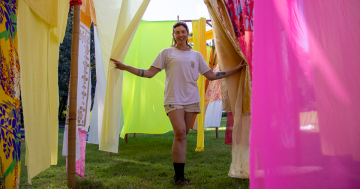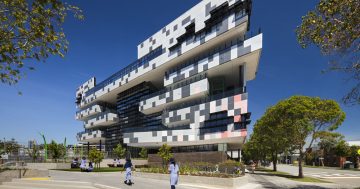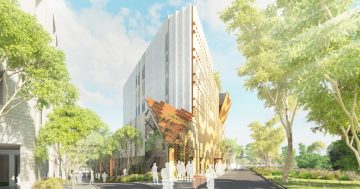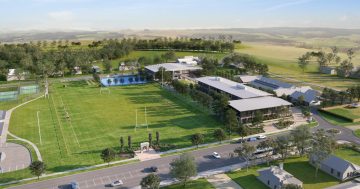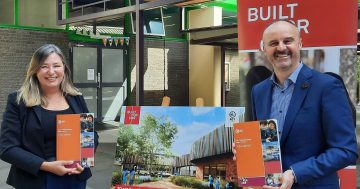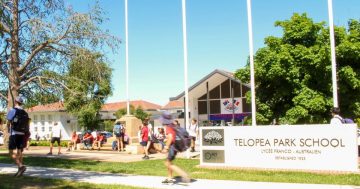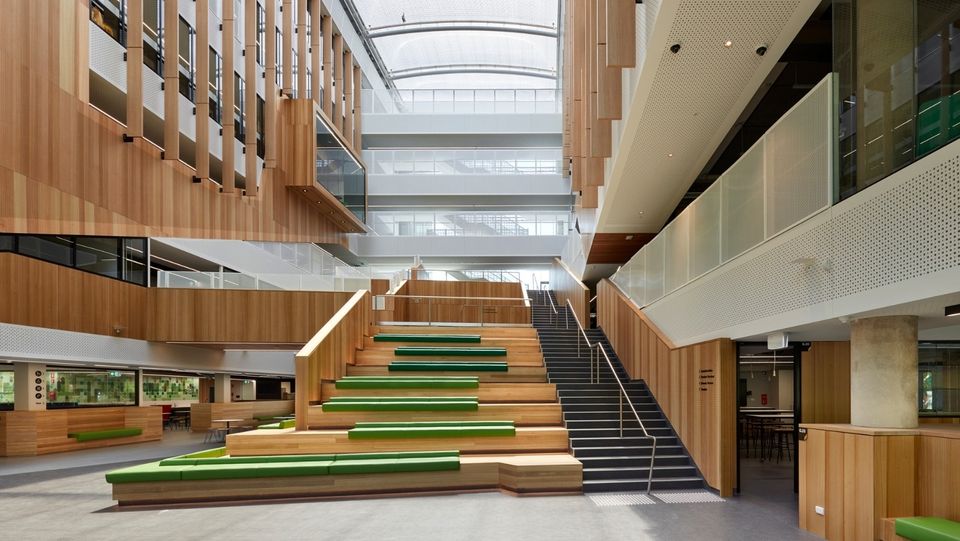
An internal view of Adelaide Botanic High School, which has seven levels and a basement. To the left of the steps is a break-out learning space. Photo: Facebook.
The construction of vertical schools in high-density areas such as town centres should be on the ACT Government’s options list, a Legislative Assembly committee has recommended.
It was one of 26 recommendations made by the Standing Committee on Education and Community Inclusion in its report on the Inquiry into the Future of School Infrastructure in the ACT.
Vertical or multi-storey schools of more than three storeys in height are becoming more common in the inner urban areas of larger Australian cities, but there are none as yet in the ACT, despite calls from the ACT Council of Parents & Citizens Associations and housing lobby Greater Canberra for the government to start planning for vertical schools in the growing Town Centres of Belconnen and Woden.
Education Minister Yvette Berry said last year that the government was looking to reserve land in the Woden Town Centre for a school when there was enough demand to support it.
At present, the government feels that the schools surrounding the Town Centres are meeting current demand, but Ms Berry says she is keeping a watchful eye.
The report says vertical schools made the best use of space in denser areas and featured innovative designs for learning, recreational and storage spaces.
But the report also notes concerns about the lack of outside space, privacy, safety and parking.
The committee visited six vertical schools in Sydney, Melbourne and Adelaide:
- Cranbrook School (Bellevue Hill, NSW), where the senior school includes a new building with five levels.
- Inner Sydney High School (Surry Hills, NSW), which has 14 levels, including two basement levels.
- Prahran High School (Prahan, Vic), which has four levels.
- Richmond High School (Richmond, Vic.), which has four levels.
- Adelaide Botanic High School (Adelaide, SA), which has seven levels and abasement level.
- Adelaide High School (Adelaide, SA), which includes a building with four levels.
Takeaways included using flexible learning spaces resulting in innovative teaching practices such as team teaching and the clever use of indoor space, often involving using the same spaces in multiple ways.
For example, stairways doubled as seating for learning or audience spaces.
Outdoor spaces such as rooftops provided recreation areas for students while space-saving storage solutions were deployed.
Noise-dampening was also a feature, given the importance of acoustics in vertical schools.
The committee also learned how schools developed close connections with the surrounding community and shared each other’s facilities.
For example, students at Adelaide Botanic High School and Inner Sydney High School can access neighbouring community land during school hours. The aquatic facilities at Cranbrook Senior School are also hired out to the community, providing a revenue resource outside school hours.
However, the committee also observed challenges.
Some vertical schools had access to adjoining large outdoor spaces, while others had to transport students to parks or ovals, and there was limited access to facilities such as halls, gymnasiums and performing arts spaces.
Some had to regularly hire community sporting facilities for physical education or opted to have a school sporting campus separate from the main school facilities.
In some cases, not all students can be accommodated in a single area for school assemblies and events.
The report says that any consideration of vertical school design should optimise the availability of outdoor and physical education spaces, including the use of basement levels.
The report also recommends centralising school infrastructure work and spending to relieve individual schools of the administrative burden of managing their own work programs and budgets.
Principals say this can be time-consuming and stressful, distracting from the core business of teaching.
The Australian Education Union ACT agrees, saying it would be better for the Education Directorate to provide building services to schools.












